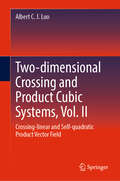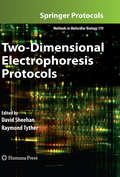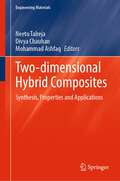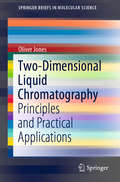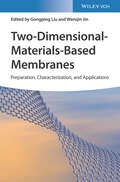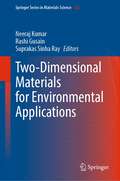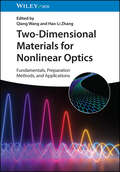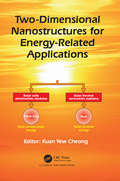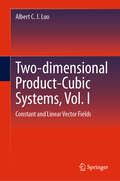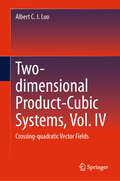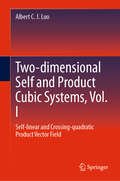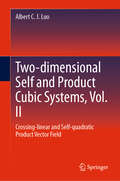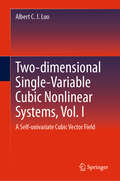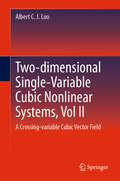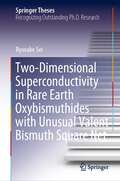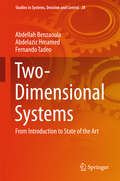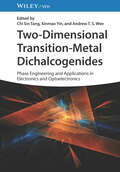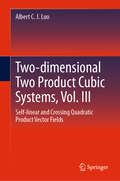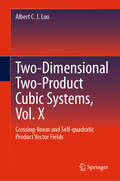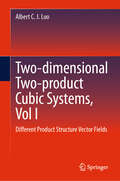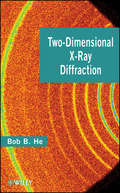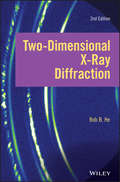- Table View
- List View
Two-dimensional Crossing and Product Cubic Systems, Vol. II: Crossing-linear and Self-quadratic Product Vector Field
by Albert C. LuoThis book, the 15th of 15 related monographs on Cubic Dynamic Systems, discusses crossing and product cubic systems with a crossing-linear and self-quadratic product vector field. The author discusses series of singular equilibriums and hyperbolic-to-hyperbolic-scant flows that are switched through the hyperbolic upper-to-lower saddles and parabola-saddles and circular and hyperbolic upper-to-lower saddles infinite-equilibriums. Series of simple equilibrium and paralleled hyperbolic flows are also discussed, which are switched through inflection-source (sink) and parabola-saddle infinite-equilibriums. Nonlinear dynamics and singularity for such crossing and product cubic systems are presented. In such cubic systems, the appearing bifurcations are: parabola-saddles, hyperbolic-to-hyperbolic-secant flows, third-order saddles (centers) and parabola-saddles (saddle-center).
Two-dimensional Crossing-Variable Cubic Nonlinear Systems
by Albert C. LuoThis book is the fourth of 15 related monographs presents systematically a theory of crossing-cubic nonlinear systems. In this treatment, at least one vector field is crossing-cubic, and the other vector field can be constant, crossing-linear, crossing-quadratic, and crossing-cubic. For constant vector fields, the dynamical systems possess 1-dimensional flows, such as parabola and inflection flows plus third-order parabola flows. For crossing-linear and crossing-cubic systems, the dynamical systems possess saddle and center equilibriums, parabola-saddles, third-order centers and saddles (i.e, (3rd UP+:UP+)-saddle and (3rdUP-:UP-)-saddle) and third-order centers (i.e., (3rd DP+:DP-)-center, (3rd DP-, DP+)-center) . For crossing-quadratic and crossing-cubic systems, in addition to the first and third-order saddles and centers plus parabola-saddles, there are (3:2)parabola-saddle and double-inflection saddles, and for the two crossing-cubic systems, (3:3)-saddles and centers exist. Finally,the homoclinic orbits with centers can be formed, and the corresponding homoclinic networks of centers and saddles exist. Readers will learn new concepts, theory, phenomena, and analytic techniques, including · Constant and crossing-cubic systems · Crossing-linear and crossing-cubic systems · Crossing-quadratic and crossing-cubic systems · Crossing-cubic and crossing-cubic systems · Appearing and switching bifurcations · Third-order centers and saddles · Parabola-saddles and inflection-saddles · Homoclinic-orbit network with centers · Appearing bifurcations
Two-Dimensional Electrophoresis Protocols
by David Sheehan Raymond TytherTwo-dimensional electrophoresis (2-DE) remains one of the most popular techniques for proteomic comparisons. Revolutionized by the development of immobilized pH gradient strips, this vital process has benefited greatly from recent developments in staining, mass spectrometry, and bioinformatics. In Two-Dimensional Electrophoresis Protocols, expert researchers examine these cutting edge proteomics methodologies, explore their application to a wide range of biological materials, and look at how these developments have helped standardize the design, execution, and analysis of proteomics experiments. Chapters reflect key steps in 2-DE experiments, including sample preparation, staining, post-translational modification, spot identification, and bioinformatics. Composed in the highly successful Methods in Molecular Biology series format, each chapter contains a brief introduction, step-by-step methods, a list of necessary materials, and a Notes section which shares tips on troubleshooting and avoiding known pitfalls. Innovative and reader-friendly, Two-Dimensional Electrophoresis Protocols encourages newcomers to apply powerful 2-DE techniques to their own research, while also providing current and essential information for seasoned scientists.
Two-dimensional Hybrid Composites: Synthesis, Properties and Applications (Engineering Materials)
by Neetu Talreja Divya Chauhan Mohammad AshfaqThis book highlights a comprehensive review of synthesis, properties, and strategies to improve the applicability of 2D materials like graphene, borophenes, metal nanosheets, phosphorene, and transition metal dichalcogenides (TMDs). It also highlights the synthesis of 2D-based hybrid composite materials and their effects on applicability, especially in energy, environment, and biomedical applications, by incorporating surface functional groups, metal/non-metal ions, and polymers. The advancement in innovative technology and use of 2D-based hybrid composite materials can improve the development of newer products/opening newer possibilities to fight existing issues related to environment, energy, and biomedical sciences. However, researchers continue to face numerous challenges in developing newer products/possibilities, large-scale production, with health and environmental impact being a challenge.This book serves as a valuable resource for researchers, professionals and students working in the field of advanced materials, especially 2D-based hybrid composites.
Two-Dimensional Liquid Chromatography: Principles and Practical Applications (SpringerBriefs in Molecular Science)
by Oliver JonesThis book addresses the growing interest in the field of two-dimensional liquid chromatography (2DLC), a powerful approach to increasing resolution, available peak capacity, and selectivity in analytical chromatography. 2DLC is suitable for many applications, including in the pharmaceutical and polymer industries and the omic sciences (metabolomics, lipidomics and proteomics). Thanks to recent advances in technology and software the instrumentation needed to perform 2D-LC is broadly available to the analytical community in both industry and academia. Indeed, the technique can now be considered ready for application in R&D as well as in QA and QC labs, yet it is not widely known about outside academic laboratories and is rarely taught at the undergraduate level. This book outlines the main principles and features of 2D-LC (including comprehensive and heart-cutting modes, method development and real world applications) to enable modern analysts to start using this fascinating technique. The book offers an ideal starting point for those wishing to get into 2D-LC and will also be of interest to more experienced scientists in the field.
Two-Dimensional-Materials-Based Membranes: Preparation, Characterization, and Applications
by Gongping LiuTwo-Dimensional-Materials-Based Membranes An authoritative and up to date discussion of two-dimensional materials and membranes In Two-Dimensional-Materials-Based Membranes: Preparation, Characterization, and Applications, a team of distinguished chemical engineers delivers a comprehensive exploration of the latest advances in design principles, synthesis approaches, and applications of two-dimensional (2D) materials—like graphene, metal-organic frameworks (MOFs), 2D layered double hydroxides, and MXene—and highlights the significance and development of these membranes. In the book, the authors discuss the use of membranes to achieve high-efficiency separation and to address the challenges posed in the field. The book also discusses potential challenges and benefits in the future development of advanced 2D nanostructures, as well as their impending implementation in applications in the fields of energy, sustainability, catalysis, electronics, and biotechnology. Readers will also find: A thorough introduction to fabrication methods for 2D-materials-based membranes, including the synthesis of nanosheets, membrane structures, and fabrication methods Descriptions of three types of 2D-materials-based membranes: single-layer membranes, laminar membranes and mixed-matrix membranes Comprehensive discussions of 2D-materials-based membranes for water and ions separation, solvent-water separation and gas separation Explorations of transport mechanism of 2D-materials-based membranes for molecular separations Perfect for membrane scientists, inorganic chemists, and materials scientists, Two-Dimensional-Materials-Based Membranes will also earn a place in the libraries of chemical and process engineers in industrial environments.
Two-Dimensional Materials for Environmental Applications (Springer Series in Materials Science #332)
by Neeraj Kumar Rashi Gusain Suprakas Sinha RayThis book focuses on recent developments in the field of two-dimensional nanomaterials for environmental applications. Due to their high surface area and tunable surface chemistry, two-dimensional nanomaterials are currently garnering great interest for environmental remediation applications. This book compiles contributed chapters from active international researchers dealing with the development of state-of-the-art two-dimensional nanomaterials in environmental applications such as water and wastewater treatment, adsorption, photocatalysis, membrane separation, desalination, deionization, environmental pollutants sensing/detection, carbon-dioxide capture and catalytic conversion, microbial treatment, and electrochemical remediation. Each chapter provides an essential and comprehensive overview of the recent advances in material development and application, giving special attention to preparation methods, tunning of physiochemical properties, surface and interface chemistry, structural porosity, assemblies integration for fabrication of devices, and their relationship with overall efficiency. It offers a valuable reference guide for environmental and materials scientists, engineers, and policymakers working towards environmental sustainability.
Two-Dimensional Materials for Nonlinear Optics: Fundamentals, Preparation Methods, and Applications
by Qiang Wang; Hao-Li ZhangTwo-Dimensional Materials for Nonlinear Optics Comprehensive resource covering concepts, perspectives, and skills required to understand the preparation, nonlinear optics, and applications of two-dimensional (2D) materials Bringing together many interdisciplinary experts in the field of 2D materials with their applications in nonlinear optics, Two-Dimensional Materials for Nonlinear Optics covers preparation methods for various novel 2D materials, such as transition metal dichalcogenides (TMDs) and single elemental 2D materials, excited-state dynamics of 2D materials behind their outstanding performance in photonic devices, instrumentation for exploring the photoinduced excited-state dynamics of the 2D materials spanning a wide time scale from ultrafast to slow, and future trends of 2D materials on a series of issues like fabrications, dynamic investigations, and photonic/optoelectronic applications. Powerful nonlinear optical characterization techniques, such as Z-scan measurement, femtosecond transient absorption spectroscopy, and microscopy, are also introduced. Edited by two highly qualified academics with extensive experience in the field, Two-Dimensional Materials for Nonlinear Optics covers sample topics such as: Foundational knowledge on nonlinear optical properties, and fundamentals and preparation methods of 2D materials with nonlinear optical properties Modulation and enhancement of optical nonlinearity in 2D materials, and nonlinear optical characterization techniques for 2D materials and their applications in a specific field Novel nonlinear optical imaging systems, ultrafast time-resolved spectroscopy for investigating carrier dynamics in emerging 2D materials, and transient terahertz spectroscopy 2D materials for optical limiting, saturable absorber, second and third harmonic generation, nanolasers, and space use With collective insight from researchers in many different interdisciplinary fields, Two-Dimensional Materials for Nonlinear Optics is an essential resource for materials scientists, solid state chemists and physicists, photochemists, and professionals in the semiconductor industry who are interested in understanding the state of the art in the field.
Two-Dimensional Nanostructures for Energy-Related Applications
by Kuan Yew CheongThis edited book focuses on the latest advances and development of utilizing two-dimensional nanostructures for energy and its related applications. Traditionally, the geometry of this material refers to "thin film" or "coating." The book covers three main parts, beginning with synthesis, processing, and property of two-dimensional nanostructures for active and passive layers followed by topics on characterization of the materials. It concludes with topics relating to utilization of the materials for usage in devises for energy and its related applications.
Two-Dimensional Optical Spectroscopy
by Minhaeng ChoTwo-Dimensional Optical Spectroscopy discusses the principles and applications of newly emerging two-dimensional vibrational and optical spectroscopy techniques. It provides a detailed account of basic theory required for an understanding of two-dimensional vibrational and electronic spectroscopy. It also bridges the gap between the formal developm
Two-dimensional Product-Cubic Systems, Vol. I: Constant and Linear Vector Fields
by Albert C. LuoThis book, the fifth of 15 related monographs, presents systematically a theory of product-cubic nonlinear systems with constant and single-variable linear vector fields. The product-cubic vector field is a product of linear and quadratic different univariate functions. The hyperbolic and hyperbolic-secant flows with directrix flows in the cubic product system with a constant vector field are discussed first, and the cubic product systems with self-linear and crossing-linear vector fields are discussed. The inflection-source (sink) infinite equilibriums are presented for the switching bifurcations of a connected hyperbolic flow and saddle with hyperbolic-secant flow and source (sink) for the connected the separated hyperbolic and hyperbolic-secant flows. The inflection-sink and source infinite-equilibriums with parabola-saddles are presented for the switching bifurcations of a separated hyperbolic flow and saddle with a hyperbolic-secant flow and center. Readers learn new concepts, theory, phenomena, and analysis techniques, such as Constant and product-cubic systems, Linear-univariate and product-cubic systems, Hyperbolic and hyperbolic-secant flows, Connected hyperbolic and hyperbolic-secant flows, Separated hyperbolic and hyperbolic-secant flows, Inflection-source (sink) Infinite-equilibriums and Infinite-equilibrium switching bifurcations.
Two-dimensional Product-Cubic Systems, Vol. IV: Crossing-quadratic Vector Fields
by Albert C. LuoThis book, the eighth of 15 related monographs, discusses a product-cubic dynamical system possessing a product-cubic vector field and a crossing-univariate quadratic vector field. It presents equilibrium singularity and bifurcation dynamics, and . the saddle-source (sink) examined is the appearing bifurcations for saddle and source (sink). The double-inflection saddle equilibriums are the appearing bifurcations of the saddle and center, and also the appearing bifurcations of the network of saddles and centers. The infinite-equilibriums for the switching bifurcations featured in this volume include: Parabola-source (sink) infinite-equilibriums, Inflection-source (sink) infinite-equilibriums, Hyperbolic (circular) sink-to source infinite-equilibriums, Hyperbolic (circular) lower-to-upper saddle infinite-equilibriums.
Two-dimensional Product Cubic Systems, Vol. VII: Self- Quadratic Vector Fields
by Albert C. LuoThis book is the seventh of 15 related monographs, concerns nonlinear dynamics and singularity of cubic dynamical systems possessing a product-cubic vector field and a self-univariate quadratic vector field. The equilibrium singularity and bifurcation dynamics are discussed. The saddle-source (sink) is the appearing bifurcations for saddle and source (sink). The double-saddle equilibriums are the appearing bifurcations of the saddle-source and saddle-sink, and also the appearing bifurcations of the network of saddles, sink and source. The infinite-equilibriums for the switching bifurcations include: • inflection-saddle infinite-equilibriums, • hyperbolic-source (sink) infinite-equilibriums, • up-down (down-up) saddle infinite-equilibriums, • inflection-source (sink) infinite-equilibriums.
Two-dimensional Self and Product Cubic Systems, Vol. I: Self-linear and Crossing-quadratic Product Vector Field
by Albert C. LuoThis book, the 14th of 15 related monographs on Cubic Dynamical Systems, discusses crossing and product cubic systems with a self-linear and crossing-quadratic product vector field. Dr. Luo discusses singular equilibrium series with inflection-source (sink) flows that are switched with parabola-source (sink) infinite-equilibriums. He further describes networks of simple equilibriums with connected hyperbolic flows are obtained, which are switched with inflection-source (sink) and parabola-saddle infinite-equilibriums, and nonlinear dynamics and singularity for such crossing and product cubic systems. In such cubic systems, the appearing bifurcations are: double-inflection saddles, inflection-source (sink) flows, parabola-saddles (saddle-center), third-order parabola-saddles, third-order saddles (centers), third-order saddle-source (sink).
Two-dimensional Self and Product Cubic Systems, Vol. II: Crossing-linear and Self-quadratic Product Vector Field
by Albert C. LuoThis book is the thirteenth of 15 related monographs on Cubic Dynamical Systems, discusses self- and product-cubic systems with a crossing-linear and self-quadratic products vector field. Equilibrium series with flow singularity are presented and the corresponding switching bifurcations are discussed through up-down saddles, third-order concave-source (sink), and up-down-to-down-up saddles infinite-equilibriums. The author discusses how equilibrium networks with paralleled hyperbolic and hyperbolic-secant flows exist in such cubic systems, and the corresponding switching bifurcations obtained through the inflection-source and sink infinite-equilibriums. In such cubic systems, the appearing bifurcations are: saddle-source (sink) hyperbolic-to-hyperbolic-secant flows double-saddle third-order saddle, sink and source third-order saddle-source (sink)
Two-dimensional Single-Variable Cubic Nonlinear Systems, Vol. I: A Self-univariate Cubic Vector Field
by Albert C. LuoThis book is the first of 15 related monographs, presents systematically a theory of cubic nonlinear systems with single-variable vector fields. The cubic vector fields are of self-variables and are discussed as the first part of the book. The 1-dimensional flow singularity and bifurcations are discussed in such cubic systems. The appearing and switching bifurcations of the 1-dimensional flows in such 2-dimensional cubic systems are for the first time to be presented. Third-order source and sink flows are presented, and the third-order parabola flows are also presented. The infinite-equilibriums are the switching bifurcations for the first and third-order source and sink flows, and the second-order saddle flows with the first and third-order parabola flows, and the inflection flows. The appearing bifurcations in such cubic systems includes saddle flows and third-order source (sink) flows, inflection flows and third-order up (down)-parabola flows.
Two-dimensional Single-Variable Cubic Nonlinear Systems, Vol II: A Crossing-variable Cubic Vector Field
by Albert C. LuoThis book, the second of 15 related monographs, presents systematically a theory of cubic nonlinear systems with single-variable vector fields. The cubic vector fields are of crossing-variables, which are discussed as the second part. The 1-dimensional flow singularity and bifurcations are discussed in such cubic systems. The appearing and switching bifurcations of the 1-dimensional flows in such 2-diemnsional cubic systems are for the first time to be presented. Third-order parabola flows are presented, and the upper and lower saddle flows are also presented. The infinite-equilibriums are the switching bifurcations for the first and third-order parabola flows, and inflection flows with the first source and sink flows, and the upper and lower-saddle flows. The appearing bifurcations in such cubic systems includes inflection flows and third-order parabola flows, upper and lower-saddle flows. Readers will learn new concepts, theory, phenomena, and analytic techniques, including Constant and crossing-cubic systems Crossing-linear and crossing-cubic systems Crossing-quadratic and crossing-cubic systems Crossing-cubic and crossing-cubic systems Appearing and switching bifurcations Third-order centers and saddles Parabola-saddles and inflection-saddles Homoclinic-orbit network with centers Appearing bifurcations
Two-Dimensional Superconductivity in Rare Earth Oxybismuthides with Unusual Valent Bismuth Square Net (Springer Theses)
by Ryosuke SeiThis book elucidates fascinating electronic phenomena of unusual Bi2-square net in layered R2O2Bi (R: rare earth) compounds using two approaches: the fabrication of epitaxial thin films and the synthesis of bulk polycrystalline powders. The Bi2-square net compounds are a promising platform to explore exotic physical properties originating from the interplay between a two-dimensional electronic state and strong spin–orbit coupling; however, there are few reports on Bi2-square net compounds due to the instability of unusual electronic configurations. The book presents the development of synthetic routes for R2O2Bi compounds, such as novel solid phase epitaxy techniques and chemical control of crystal structure, demonstrating the intrinsic physical properties of Bi2-square net for the first time. The most notable finding is the successful induction of two-dimensional superconductivity in Bi2-square net with the coexistence of rich electronic phases. The book also discusses the superconducting mechanisms and the effect of R cation substitution in detail and describes the mechanical properties of Bi2-square net. These findings overturn the results of previous studies of R2O2Bi. The book sheds light on hidden layered compounds, representing a significant advance in the field.
Two-Dimensional Systems
by Abdellah Benzaouia Abdelaziz Hmamed Fernando TadeoA solution permitting the stabilization of 2-dimensional (2-D) continuous-time saturated system under state feedback control is presented in this book. The problems of delay and saturation are treated at the same time. The authors obtain novel results on continuous 2-D systems using the unidirectional Lyapunov function. The control synthesis and the saturation and delay conditions are presented as linear matrix inequalities. Illustrative examples are worked through to show the effectiveness of the approach and many comparisons are made with existing results. The second half of the book moves on to consider robust stabilization and filtering of 2-D systems with particular consideration being given to 2-D fuzzy systems. Solutions for the filter-design problems are demonstrated by computer simulation. The text builds up to the development of state feedback control for 2-D Takagi-Sugeno systems with stochastic perturbation. Conservatism is reduced by using slack matrices and the coupling between the Lyapunov matrix and the system matrices is broken by using basis-dependent Lyapunov functions. Mean-square asymptotic stability and prescribed H-infinity performance are guaranteed. Two-Dimensional Systems emphasizes practical approaches to control and filter design under constraints that appear in real problems and uses off-the-shelf software to achieve its results. Researchers interested in control and filter design for multidimensional systems, especially multi-dimensional fuzzy systems, will find this book a useful resource as will graduate students specializing in dynamical sytems.
Two-Dimensional Transition-Metal Dichalcogenides: Phase Engineering and Applications in Electronics and Optoelectronics
by Chi Sin Tang Xinmao Yin Andrew T. S. WeeTwo-Dimensional Transition-Metal Dichalcogenides Comprehensive resource covering rapid scientific and technological development of polymorphic two-dimensional transition-metal dichalcogenides (2D-TMDs) over a range of disciplines and applications Two-Dimensional Transition-Metal Dichalcogenides: Phase Engineering and Applications in Electronics and Optoelectronics provides a discussion on the history of phase engineering in 2D-TMDs as well as an in-depth treatment on the structural and electronic properties of 2D-TMDs in their respective polymorphic structures. The text addresses different forms of in-situ synthesis, phase transformation, and characterization methods for 2D-TMD materials and provides a comprehensive treatment of both the theoretical and experimental studies that have been conducted on 2D-TMDs in their respective phases. Two-Dimensional Transition-Metal Dichalcogenides includes further information on: Thermoelectric, fundamental spin-orbit structures, Weyl semi-metallic, and superconductive and related ferromagnetic properties that 2D-TMD materials possess Existing and prospective applications of 2D-TMDs in the field of electronics and optoelectronics as well as clean energy, catalysis, and memristors Magnetism and spin structures of polymorphic 2D-TMDs and further considerations on the challenges confronting the utilization of TMD-based systems Recent progress of mechanical exfoliation and the application in the study of 2D materials and other modern opportunities for progress in the field Two-Dimensional Transition-Metal Dichalcogenides provides in-depth review introducing the electronic properties of two-dimensional transition-metal dichalcogenides with updates to the phase engineering transition strategies and a diverse range of arising applications, making it an essential resource for scientists, chemists, physicists, and engineers across a wide range of disciplines.
Two-dimensional Two Product Cubic Systems, Vol. III: Self-linear and Crossing Quadratic Product Vector Fields
by Albert C. LuoThis book is the eleventh of 15 related monographs on Cubic Systems, examines self-linear and crossing-quadratic product systems. It discusses the equilibrium and flow singularity and bifurcations, The double-inflection saddles featured in this volume are the appearing bifurcations for two connected parabola-saddles, and also for saddles and centers. The parabola saddles are for the appearing bifurcations of saddle and center. The inflection-source and sink flows are the appearing bifurcations for connected hyperbolic and hyperbolic-secant flows. Networks of higher-order equilibriums and flows are presented. For the network switching, the inflection-sink and source infinite-equilibriums exist, and parabola-source and sink infinite-equilibriums are obtained. The equilibrium networks with connected hyperbolic and hyperbolic-secant flows are discussed. The inflection-source and sink infinite-equilibriums are for the switching bifurcation of two equilibrium networks.
Two-dimensional Two-product Cubic Systems Vol. X: Crossing-linear and Self-quadratic Product Vector Fields
by Albert C. LuoThis book is the tenth of 15 related monographs, discusses product-cubic nonlinear systems with two crossing-linear and self-quadratic products vector fields and the dynamic behaviors and singularity are presented through the first integral manifolds. The equilibrium and flow singularity and bifurcations discussed in this volume are for the appearing and switching bifurcations. The double-saddle equilibriums described are the appearing bifurcations for saddle source and saddle-sink, and for a network of saddles, sink and source. The infinite-equilibriums for the switching bifurcations are also presented, specifically: · Inflection-saddle infinite-equilibriums, · Hyperbolic (hyperbolic-secant)-sink and source infinite-equilibriums · Up-down and down-up saddle infinite-equilibriums, · Inflection-source (sink) infinite-equilibriums.
Two-dimensional Two-product Cubic Systems, Vol I: Different Product Structure Vector Fields
by Albert C. LuoThis book is the ninth of 15 related monographs, discusses a two product-cubic dynamical system possessing different product-cubic structures and the equilibrium and flow singularity and bifurcations for appearing and switching bifurcations. The appearing bifurcations herein are parabola-saddles, saddle-sources (sinks), hyperbolic-to-hyperbolic-secant flows, and inflection-source (sink) flows. The switching bifurcations for saddle-source (sink) with hyperbolic-to-hyperbolic-secant flows and parabola-saddles with inflection-source (sink) flows are based on the parabola-source (sink), parabola-saddles, inflection-saddles infinite-equilibriums. The switching bifurcations for the network of the simple equilibriums with hyperbolic flows are parabola-saddles and inflection-source (sink) on the inflection-source and sink infinite-equilibriums. Readers will learn new concepts, theory, phenomena, and analysis techniques. · Two-different product-cubic systems · Hybrid networks of higher-order equilibriums and flows · Hybrid series of simple equilibriums and hyperbolic flows · Higher-singular equilibrium appearing bifurcations · Higher-order singular flow appearing bifurcations · Parabola-source (sink) infinite-equilibriums · Parabola-saddle infinite-equilibriums · Inflection-saddle infinite-equilibriums · Inflection-source (sink) infinite-equilibriums · Infinite-equilibrium switching bifurcations.
Two-dimensional X-Ray Diffraction
by B. B. HeWritten by one of the pioneers of 2D X-Ray Diffraction, this useful guide covers the fundamentals, experimental methods and applications of two-dimensional x-ray diffraction, including geometry convention, x-ray source and optics, two-dimensional detectors, diffraction data interpretation, and configurations for various applications, such as phase identification, texture, stress, microstructure analysis, crystallinity, thin film analysis and combinatorial screening. Experimental examples in materials research, pharmaceuticals, and forensics are also given. This presents a key resource to researchers in materials science, chemistry, physics, and pharmaceuticals, as well as graduate-level students in these areas.
Two-dimensional X-ray Diffraction
by Bob B. HeAn indispensable resource for researchers and students in materials science, chemistry, physics, and pharmaceuticals Written by one of the pioneers of 2D X-Ray Diffraction, this updated and expanded edition of the definitive text in the field provides comprehensive coverage of the fundamentals of that analytical method, as well as state-of-the art experimental methods and applications. Geometry convention, x-ray source and optics, two-dimensional detectors, diffraction data interpretation, and configurations for various applications, such as phase identification, texture, stress, microstructure analysis, crystallinity, thin film analysis, and combinatorial screening are all covered in detail. Numerous experimental examples in materials research, manufacture, and pharmaceuticals are provided throughout. Two-dimensional x-ray diffraction is the ideal, non-destructive analytical method for examining samples of all kinds including metals, polymers, ceramics, semiconductors, thin films, coatings, paints, biomaterials, composites, and more. Two-Dimensional X-Ray Diffraction, Second Edition is an up-to-date resource for understanding how the latest 2D detectors are integrated into diffractometers, how to get the best data using the 2D detector for diffraction, and how to interpret this data. All those desirous of setting up a 2D diffraction in their own laboratories will find the author’s coverage of the physical principles, projection geometry, and mathematical derivations extremely helpful. Features new contents in all chapters with most figures in full color to reveal more details in illustrations and diffraction patterns Covers the recent advances in detector technology and 2D data collection strategies that have led to dramatic increases in the use of two-dimensional detectors for x-ray diffraction Provides in-depth coverage of new innovations in x-ray sources, optics, system configurations, applications and data evaluation algorithms Contains new methods and experimental examples in stress, texture, crystal size, crystal orientation and thin film analysis Two-Dimensional X-Ray Diffraction, Second Edition is an important working resource for industrial and academic researchers and developers in materials science, chemistry, physics, pharmaceuticals, and all those who use x-ray diffraction as a characterization method. Users of all levels, instrument technicians and X-ray laboratory managers, as well as instrument developers, will want to have it on hand.
